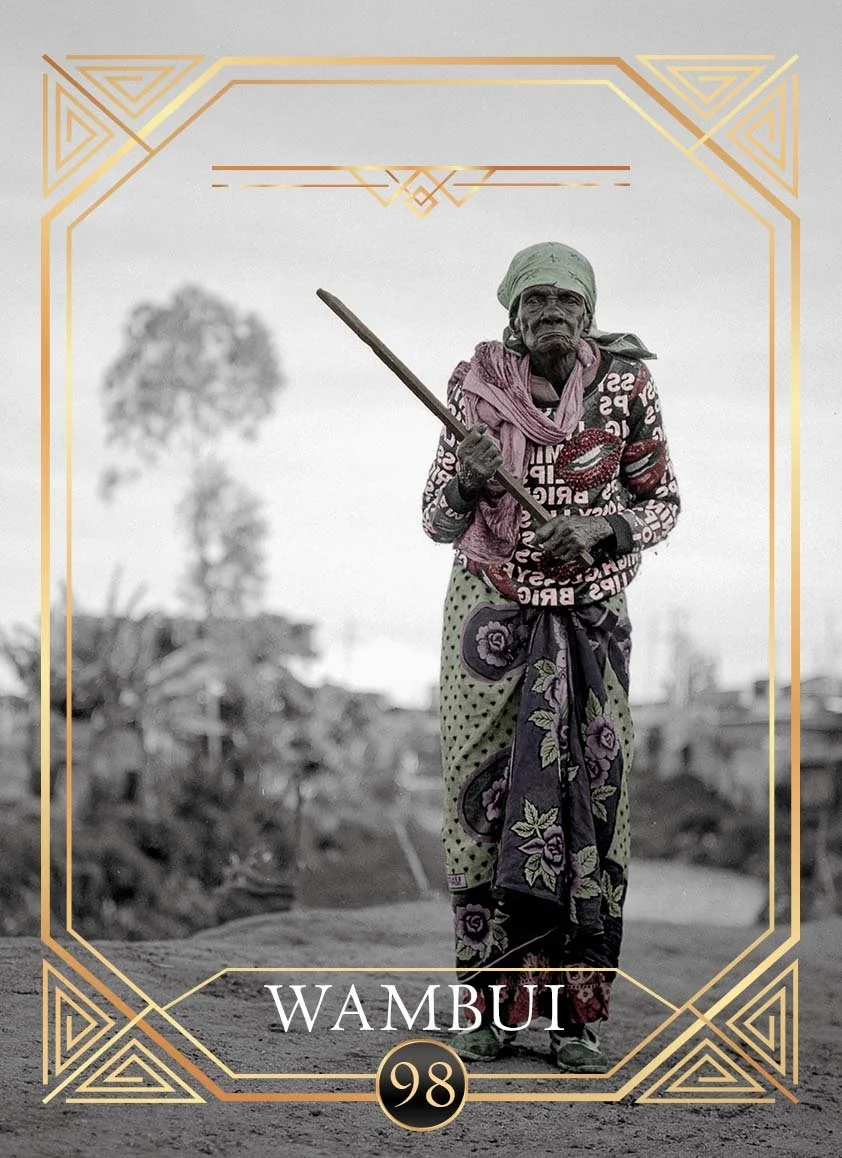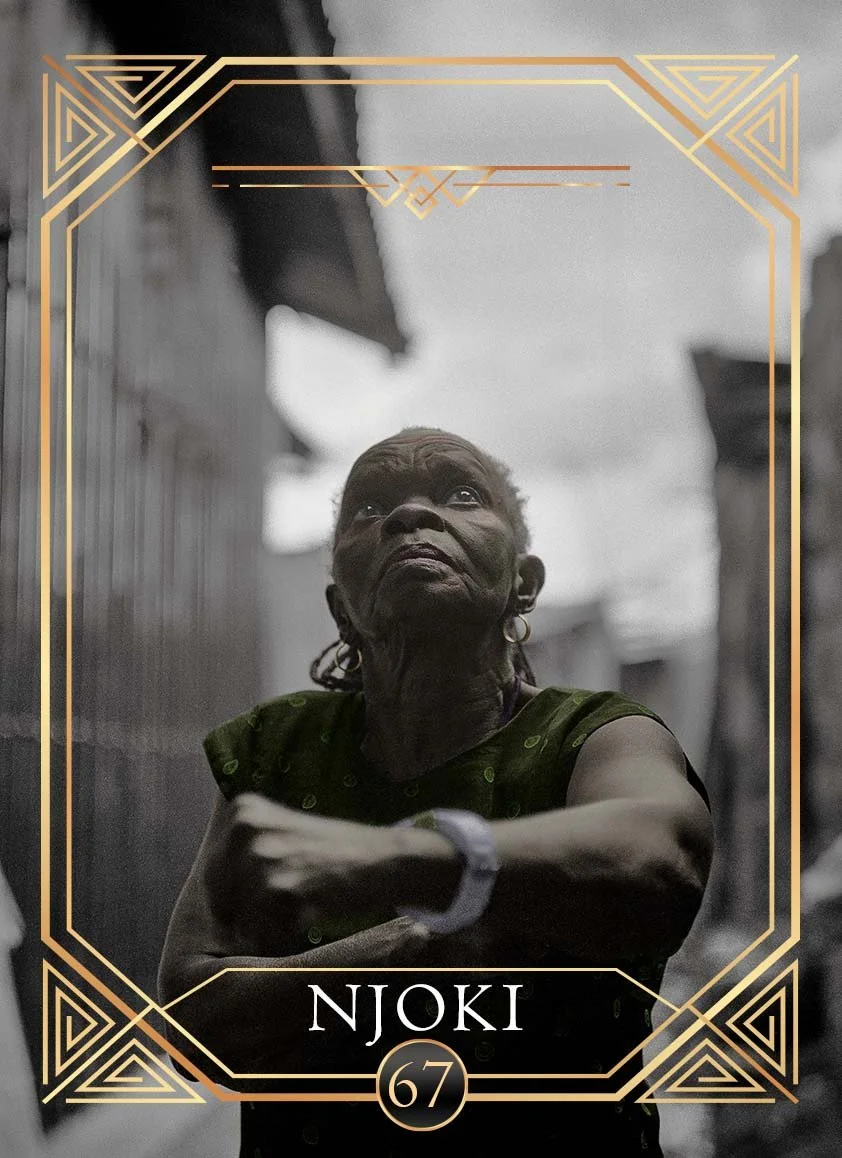Feature: Tobin Jones Korogocho Grannies Project Review
TOBIN JONES, Super Granny Tutu
Written by: Sophie Yates
Copyedited by: Jana Massoud
Within Nairobi, Kenya, lies a neighborhood called Korogocho where a group of grandmothers have mastered the art of Kung Fu. Due to gang violence and attacks particularly on the elderly, the women founded the group and took it upon themselves to learn fighting techniques, calling themselves the Shoso Jikinge self-defense society.
Having grown up in Kenya and taken photographs there for years, award-winning photographer Tobin Jones took it upon himself to document the stories of these women, shedding a light on what it’s like to live in slums seen by few and visited by even fewer. His project titled “Super Grannies” is a collection of the grandmothers’ portraits, mostly photographed in their fighting poses.
TOBIN JONES, Super Granny Team
1. What was your motivation for this project, and why is it important for the world to know about these women?
I grew up in Kenya and worked there as a photographer for more than a decade and so had heard of the fighting grandmothers of Korogocho for a while, but had hesitated photographing them because I’d always thought it was a particularly special story and wanted to photograph them in a way that would somehow match this.
A group of fighting grandmothers sounds fun and quirky, but it has a really dark underbelly to it. In the slum where this group of older women live, Korogocho, violent attacks and even sexual assault on the elderly is not uncommon. This group came together out of a real need for self defense in order to stand up to a problem many didn’t even know existed. In the process they also built themselves a community and a support group, which has been massively positive to so many of the members. It was these two sides of the story - the good and the bad - which I really wanted to capture.
Jones described the actual process of photographing the women as easy because they welcomed him into their community and were excited to be photographed. However, Jones added that it was difficult using a manual film camera to take all of the photos.
TOBIN JONES, Super Granny Nduta
2. What was the most rewarding and fun part of photographing the women? Most difficult?
The easiest part of this project was definitely photographing the women. Portraits require that the photographer work with the subject and all of the women were just so happy to be a part of the project. I actually made the mistake of trying to photograph Wambui, one of the older of the women, on the second day instead of the first and promptly got told off by her and told that she would be going first!
The more difficult part of this project were the technical aspects. Because I wanted to do something a little different with these portraits I had decided that I'd take all of the photographs using an old Rolleiflex camera on medium format film, develop it myself, and finally colorize each of the women in photoshop. It was a fun process, but each step involved quite a bit of time, and so the entire project ended up being extremely time consuming and involving a lot of intricate work.
NFTs, Non Fungible Tokens, are a new technology with the role of selling photographs and funding the project. Jones said they played a huge role in “Super Grannies.”
TOBIN JONES, Super Granny Wambui
3. What role do NFTs play in this project, and how do you see NFTs affecting the world of photography in the future?
NFTs, or Non Fungible Tokens, make up a huge part of the backbone of this project. I know a lot of people are fairly skeptical of NFTs, and I was too initially, but I’ve now come to really believe that this new technology has the potential to revolutionize the creative industry. If you see NFTs for what they essentially are, smart digital contracts, they offer a number of advantages over the current system - namely the ability to automatically track photographs, process payments, and use royalties so that photographers continue to get paid a percentage each time their photographs are sold on to the next buyer. As a result I wanted to use this project to show how NFTs and photojournalism could be used in such a way as to not only fund projects like this in the future, but also to benefit the subjects of these types of stories.
One of the most unique aspects of Jones’ photos is that the women are in color, and the background is made black-and-white. Jones explained he did this because NFT projects seem to be more successful when people want to trade them. In order to encourage that, the photographer created them in a trading card aesthetic, similar to baseball or other sports trading cards.
TOBIN JONES, Super Granny Njoki
4. What went into your artistic decision to make the background black-and-white and leave the women with color?
A huge part of some of the most successful NFT projects out there, such as the Bored Ape Yacht Club or Woman&Weapons is the idea that they are collectible. As a result I thought it would be an interesting idea to portray these women as Superheroes and create a trading card for each of them. These could then be bought and traded in the same people's baseball cards of their favorite athletes. In order to give each a distinct personality I therefore thought I’d give each their own set of colors, which would make them look more like superheroes and separate them from their more mundane black and white backgrounds.
Jones said he wanted to give this project a vintage feel, so he experimented with different film photography techniques, using Photoshop to emulate certain ones.
TOBIN JONES, Super Granny Esther
5. What types of photography styles did you experiment with?
A huge influence of this project came from looking at old family photos, which had been taken in the early 1900s in black and white film and then physically colored by an artist. It’s a technique which for the most part died out once color film was invented, but which I’ve always wanted to emulate and thought would be an interesting way to give modern photographs a more vintage feel. Instead of physically painting the photographs, I instead used photoshop to physically paint each layer. It’s definitely easier than doing it the old fashioned way, but still requires I use a roughly similar technique and is very time consuming. An added benefit is that I also get to choose whichever colors I want.
The hope for the collection, Jones stated, is to give 10 percent of the proceeds back to the women. He said he hopes NFTs will continue to be used in the world of photography and could help benefit other communities, too.
TOBIN JONES, Super Granny Rose
6. What effects do you hope your project has on this community?
My current plan with this collection is to auction off each of the trading cards in collaboration with Art3, a new startup trying to foster the use of NFTs in the photography space. Ten percent of all the proceeds will then go back to the women, which we’re hoping will help benefit the group and show that perhaps this will be a sustainable way for photography projects to work going forward.
Instagram: @tobin_jones
Twitter: @tobinbjones
Website: www.tobinjonesphotography.com
Photo Editing by Lenin Arache














